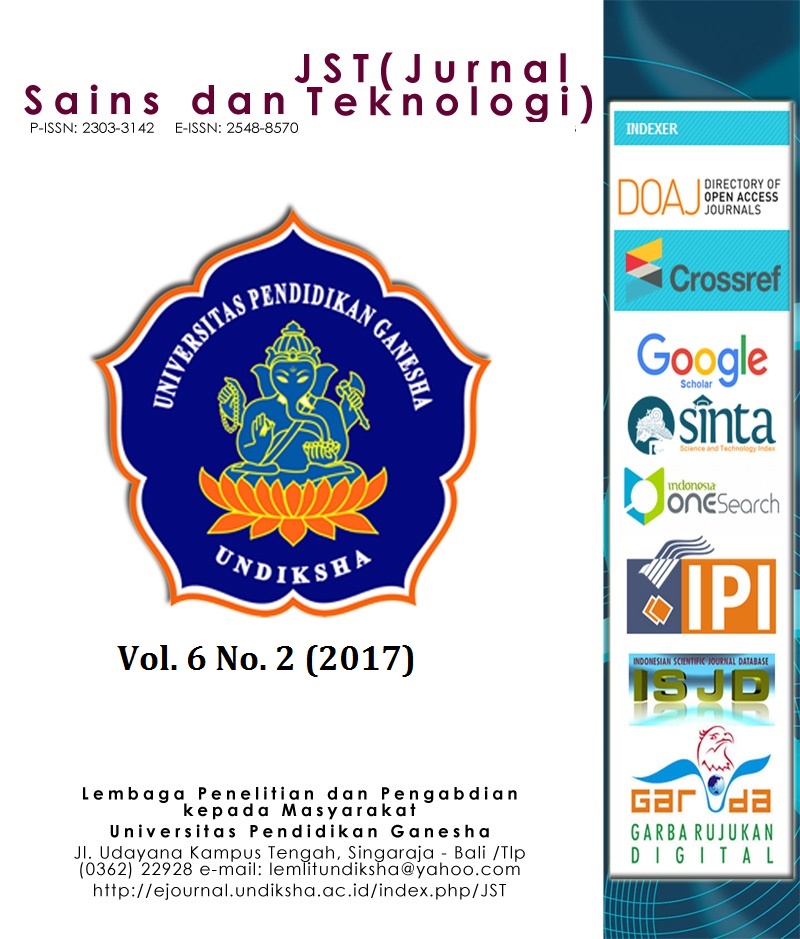Aplikasi Pengukur 3 Derajat Kebebasan Gaya Aerodinamika Pada Water Tunnel
DOI:
https://doi.org/10.23887/jstundiksha.v6i2.11785Keywords:
Peswawat tanpa awak, Load Cell, Mikrokontroler, Gaya AerodinamikaAbstract
Perkembangan teknlogi pesawat tanpa awak berkembang pesat. Dalam pembuatan sebuah peswat diperlukan analisis mengenai gaya-gaya aerodinamika yang bekerja pada pesawat tersebut. Analisis gaya aerodinamika dapat dilakukan melaui wind tunnel dan water tunnel. Pengukuran dapat dilakukan dengan visualisasi tetapi metode ini tidak memberikan nilai gaya aerodinamika secara langsung. Hal ini analisis gaya aerodinamika tidak dapat dilakukan secara langsung. Pengukuran gaya aerodinamika dapat dilakukan menggunakan sistem pengukur gaya dengan sensor load cell. Aplikasi sistem pengukur gaya aerodinamika dapat membuat analisis gaya aerodinamika secara langsung karena nilai pembacaan gaya langsung ditampilkan dalam bentuk grafik. Alat ukur ini menggunakan Load cell sebagai sensor, data dari load cell lalu di olah menggunakan mikrokontroler dan ditampilkan di komputer. Setelah dilakukan pengujian, alat pengukur gaya ini dapat mengukur gaya Drag dan gaya Lift sesuai dengan beban yang diujikan dengan error kecil. Selain itu, gaya momen dapat diketahui menggunakan sistem pengukur gaya ini. Sehingga sistem ini dapat mengukur gaya aerodinamika dengan 3 derajat kebebasan Sistem pengukur gaya ini juga bisa menunjukkan arah gaya aerodinamika yang dialami oleh obyek tesReferences
Beckner, C., & E.Curry, R. (1985). Water Tunnel Flow Visualisation. Nasa Technical Memorandum, 86743, 16.
Doebelin, E. O. (2010). Measurement System : Application and Design. University of California: McGraw-Hill.
Erm, L. P. (2004). Dynamic Testing of Aircraft Models in a Water Tunnel. Paper presented at the 15th Australasian Fluid Mechanics Conference, The University of Sydney,Sidney,Australia.
Good, G. M. L., Howell, J. P., Passmore, M. A., & Cogotti, A. (1998). A Comparison of On Road Aerodynamic Drag Measurements with Wind Tunnel Data from Pininfarina and MIRA. Paper presented at the International Congress and Exposition, Detroit,Michigan.
Husnayati, N., & Moelyadi, M. A. (2013). Analisis Aerodinamika dan Studi Parameter Sayap CN-235 Kondisi Terbang Jelajah (Aerodynamic Analysis and Parametric Sturdy Of CN-235 Wing At Cruise Condition). Jurnal Teknologi Dirgantara, 10(2), 9.
Johnston, D. L. (1954). Load Cell Force Tranducers. Journal of The British Institution of Radio Engineers, 8.
Lubis, M. M. (2012). Analisis Aerodinamika Airfoil Naca 2412 Pada Sayap Pesawat Model Tipe Glider Dengan Menggunakan Software Berbasis Computional Fluid Dinamic Untuk Memperoleh Gaya Angkat Maksimum. E-Dinamis, II(2), 10.
Ma, J., & Song, A. (2013). Fast Estimation of Strains for Cross-Beams Six-Axis Force/Torque Sensors by Mechanical Modeling. Sensors, 13, 18. doi: 10.3390
Muller, I., Brito, R. M. d., Pereira, C. E., & Brusamarello, V. (Cartographer). (2010). Load Cells In Force Sensing Analysis-Theory and a Novel Application.
Nan, L. (2013). The Methods of Drag Force Measurement in Wind Tunnels. (Master), University of Gavle.
Pifer, E. A., & Bramesfeld, G. (2012). Measuring Wing Profile Drag using an Integrating Wake Rake. Technical Soaring, 36(3), 9.
Thrift, A. A., Brumbaugh, S. J., & Thole, K. A. (2010). A Methodology to Measure Aerodynamic Forces on Cylinders in Channel Flow. Journal of Fluids Engineering, 132, 9.
Yuan, C., Luo, L.-P., Shin, K.-S., & Han, C.-S. (2013). Design and Analysis of a 6 DOF Force/Torque Sensor For Human Gait Analysis. Paper presented at the 13th International Conference on Control, Automation and System (ICCAS 2013), Kimdaejung Convention Center, Gwangju, Korea.
Downloads
Published
How to Cite
Issue
Section
License
Authors who publish with the Jurnal Sains dan Teknologi (JST) agree to the following terms:
- Authors retain copyright and grant the journal the right of first publication with the work simultaneously licensed under a Creative Commons Attribution License (CC BY-SA 4.0) that allows others to share the work with an acknowledgment of the work's authorship and initial publication in this journal.
- Authors are able to enter into separate, additional contractual arrangements for the non-exclusive distribution of the journal's published version of the work (e.g., post it to an institutional repository or publish it in a book), with an acknowledgment of its initial publication in this journal.
- Authors are permitted and encouraged to post their work online (e.g., in institutional repositories or on their website) prior to and during the submission process, as it can lead to productive exchanges, as well as earlier and greater citation of published work. (See The Effect of Open Access)
















